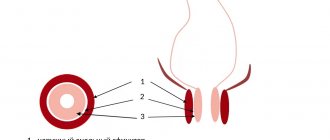Symptoms of appendicitis, first signs in adults and children
The appendix is the vermiform appendix of the cecum, and the inflammatory process that develops in this part of the intestine is classified as appendicitis. It is noteworthy that the clinical picture with the progression of the inflammatory process in the appendix of the cecum can be variable - most often, diagnosing appendicitis is not difficult, but often the symptoms can be mild.
Most often, appendicitis occurs in children aged 9–12 years, in adults between 20–40 years. Among children, the majority of patients are male, and among adults, the majority are female. It is quite difficult to explain this pattern, as well as to identify the causes of appendicitis in general.
What is appendicitis?
This is the occurrence of an inflammatory process in a small specific organ - the appendix. This organ is located on the border between the small and large intestines, being a kind of guard - it contains lymphatic tissue, which makes it an organ of the immune system.
It is located there for a reason: the small and large sections of the intestine perform different functions; moving from one department to another, food finds itself in qualitatively new conditions, so it must be “inspected” and “disinfected”. This is what the appendix does.
Stages and degrees
Appendicitis (symptoms in children 10-13 years old depend on the severity of the inflammatory process) occurs in several stages:
- the initial one lasts about 6 hours and is characterized by slight thickening of the walls of the appendix. I experience aching pain that covers the entire abdomen. They may be unstable and periodically recede;
- in the second stage (phlegmonous), which lasts until the end of the first day, the appendix enlarges, blood thickening occurs, which leads to the formation of blood clots;
- if no help was provided at the previous stage, the disease becomes gangrenous with the death of the walls of the organ;
- at the last stage, which is the most dangerous, the appendix ruptures and peritonitis develops. At this stage, urgent medical intervention is necessary.
On which side is appendicitis found in humans?
In most cases, pain with appendicitis is localized on the right, in the lower abdomen.
This characteristic of the pain syndrome and its evolution is characteristic of the classic (or typical) location of the appendix. In more than half of the cases it is located medial and inferior to the cecum - this position is called descending. This position ensures the localization of pain on the right and lower abdomen.
However, so-called atypical positions of the appendix are also known, which give a different clinical picture of the pain syndrome.
Symptoms of acute appendicitis in adults
Pronounced symptoms of appendicitis appear most often at the stage when the inflammatory process penetrates into the deep layers of the mucous membrane of the appendix, and also covers nearby structures. The first signs of appendicitis may vary and depend on the anatomical location of the appendix, the age and gender of the patient, and the duration of the pathology.
- The pain is constant, although sometimes it can be cramping, and the intensity of the pain can gradually increase. Typically, such pain does not radiate anywhere, however, with an atypical location of the appendix, pain may radiate, for example, to the lumbar region, or to the genitals (if the appendix is located in the pelvic area).
- The second most common symptom of acute appendicitis is nausea and possibly vomiting (vomiting occurs in 20-40% of patients), most often this is a single vomiting and is observed in the first hours of the disease. The appearance of vomiting is caused by irritation of the peritoneum and it usually appears after pain.
- A rise in body temperature in acute appendicitis above subfebrile values (up to 38°) is rarely observed and is not a characteristic sign of this disease. Possible increased heart rate (over 80 beats per minute) at normal body temperature. Sometimes the patient may complain of chills. Such symptoms indicate aggravation of the process.
The general condition of the sick person suffers little. He behaves calmly, more often lies on his back, less often on his right side. This can also serve as a sign of the disease, since positioning on the left side increases pain (Sitkovsky's symptom). Examination of the tongue in the first hours of the disease usually does not provide any information, since changes - dryness, furring - may appear later if the peritoneum is involved in the inflammatory process. Upon examination, it is noteworthy that the abdomen takes part in breathing, and is sometimes swollen.
Features of the flow
The disease in adolescents has its own characteristics: there are differences in clinical manifestations and course, and the risk of complications increases.
What is the main danger
Appendicitis in a child appears suddenly and in most cases develops rapidly , within 12 hours.
Rarely, symptoms may persist for 5-7 days. If the disease is not recognized in time, complications are likely that are difficult to eliminate.
If the inflamed appendix is not removed, its walls perforate . The inflammatory process quickly spreads to the peritoneum, resulting in peritonitis. This is the most dangerous consequence; the disease poses a threat to the child’s life.
Note. In adults, complications develop within 2-3 days; in a child, they can occur within 2-3 hours.
Complications
In addition to peritonitis, other, no less dangerous consequences are likely.:
- appendicular infiltrate, abscess;
- intestinal obstruction;
- sepsis.
Catarrhal (uncomplicated) appendicitis can turn into phlegmonous (accompanied by vascular thrombosis) or gangrenous (characterized by tissue necrosis) within 12-24 hours.
We recommend: What complications can occur with acute appendicitis
Symptoms of appendicitis in children
The clinical picture of symptoms of acute appendicitis in children is extremely diverse and depends on the age of the child, the location of the appendix, and the morphological stage of inflammation.
- The first signs of an inflammatory process will always be pain in the abdominal area. Most often, the initial location of pain is the navel area, a couple of fingers above it and not very painful, barely perceptible. Over time, the pain can move closer to the lower abdomen and right side, and it becomes much stronger.
- A child's condition with inflammation of the appendix will noticeably worsen: in addition to lethargy, weakness and high fever, nausea or vomiting may begin. And this happens repeatedly. Children begin to become hysterical and capricious, and refuse their favorite foods.
- When you touch their stomach, babies may scream sharply, start crying and try to wriggle out so that you leave them alone and don’t touch them anymore.
- Fever does not always occur in children, so this is not the main sign of appendicitis.
If you notice this behavior in your child, be sure to try to palpate his abdomen to find out the location of the pain. Try to do this very carefully so as not to harm the baby. If the pain is more on the right side, you should lightly press on the stomach in that area with several fingers, perhaps it is there that you will feel a small lump. If the appendix is inflamed, the pain will intensify if you suddenly remove your fingers from the place of pressure.
You can also ask the child to cough or laugh, if such actions increase the pain - this indicates the presence of acute appendicitis. Call an ambulance immediately so that doctors can make the correct diagnosis in time and provide the child with the necessary help.
Specifics, reasons
The specificity of the course of the disease in children lies in the vagueness of the symptoms, this is a serious danger, because help must be provided as quickly as possible. The prerequisites and causes of the disease in a child or teenager aged 15-16 years are usually hidden in the following factors:
- Problems with microflora;
- The appearance and accumulation of pathogenic microorganisms;
- Stagnation of feces.
Inflammation can also be a consequence of decreased immunity, increased stress and inflammation in this area, stress - these factors increase the risk of disease.
Appendicitis often occurs in adolescents, the age of 15-16 years being the most critical. Among the physiological features of the cecum during this period is excessive length, which leads to the risk of entanglement and prolapse.
Chronic appendicitis
It is represented by a long-term, sluggish inflammatory process in the appendix. Of all diagnosed pathologies of the appendix, the chronic form occurs in approximately one percent of cases and is found more often in young women. Due to the blurred clinical picture with mild symptoms of the disease, detection of chronic appendicitis is difficult.
Clinical signs of chronic appendicitis are quite variable and polymorphic, but in general they constitute a picture of a sluggish form of inflammation of the appendix. Attacks of exacerbation and periods of remission, which they are gradually replaced by, manifest themselves with their characteristic symptoms of the disease.
Symptoms of attacks of exacerbation of chronic appendicitis are:
- pain in the right iliac region, increasing in case of increased intra-abdominal pressure;
- pain in the abdominal area;
- nausea;
- vomit;
- diarrhea;
- periodic flatulence;
- body temperature is within 37.5 degrees.
The main symptom that prompts seeking medical help is pain. The pain can be constant or paroxysmal. The epicenter of pain is located in the iliac region on the right or near the navel. Sometimes waves of pain spread to the lower back, groin or right leg. Painful sensations intensify when intra-abdominal pressure increases, putting pressure on the inflamed appendix. This occurs during physical activity, coughing, sneezing, and bowel movements.
Poor nutrition also leads to increased pain. In female patients, exacerbations may occur during menstruation.
Symptoms of the period of remission of chronic appendicitis include:
- mild pain syndrome;
- decreased appetite;
- emotional lability with increased irritability;
- sleep disorders;
- decreased muscle tone of the anterior abdominal wall on the right.
The pain syndrome during the period of remission is represented by aching, dull pain in the abdomen, the localization of which is difficult to determine. Most often they appear when walking and running. In their practice, doctors use several objective symptoms that help in diagnosing chronic appendicitis.
First aid
When the first signs appear - abdominal pain and elevated body temperature - you need to call an ambulance. Self-medication is unacceptable, since appendicitis cannot be treated conservatively .
Before doctors arrive, you must adhere to the following recommendations::
- Put the child to bed and ensure immobility. He should take the most comfortable and least painful position.
- If the pain is unbearable, give an analgesic. If the teenager can still endure it, it is better to wait for the doctors to arrive, otherwise it will be difficult for them to make a diagnosis.
- Do not give a laxative or perform an enema.
- Thermal procedures are prohibited; you cannot place a heating pad on your stomach.
- If a child refuses food, you should not force feed. You can give it to drink in small sips.
By following these recommendations, you can avoid deterioration in your health.
Differential diagnosis
As has already been said many times, appendicitis can disguise itself as a variety of diseases, therefore, its differential diagnosis is carried out with a host of pathologies:
- acute cholecystitis,
- viral mesadenitis,
- pyelonephritis on the right,
- renal colic on the right,
- acute right-sided adnexitis,
- ovarian cyst rupture
- ectopic pregnancy,
- exacerbation of peptic ulcer disease,
- intestinal obstruction, etc.
After doctors are convinced of the correctness of their diagnosis, the patient is immediately treated, which can only be surgical.
Surgery for appendicitis
Surgery is the main treatment for appendicitis. The procedure is called an appendectomy and is performed under general anesthesia.
Modern medicine makes it possible to remove appendicitis with minimal consequences for the body. During the operation, small punctures are made in the abdominal wall using a special instrument, through which the inflamed organ is removed, then the punctures are sutured. This operation is considered the least invasive compared to interventions that were practiced several decades ago.
Removing the appendix using conventional abdominal surgery is considered an outdated method of treatment. It is used quite rarely, usually in clinics that do not have modern surgical equipment.
The operation is preceded by a fairly long recovery period, when the patient is prohibited from engaging in physical activity and eating “junk food.”









